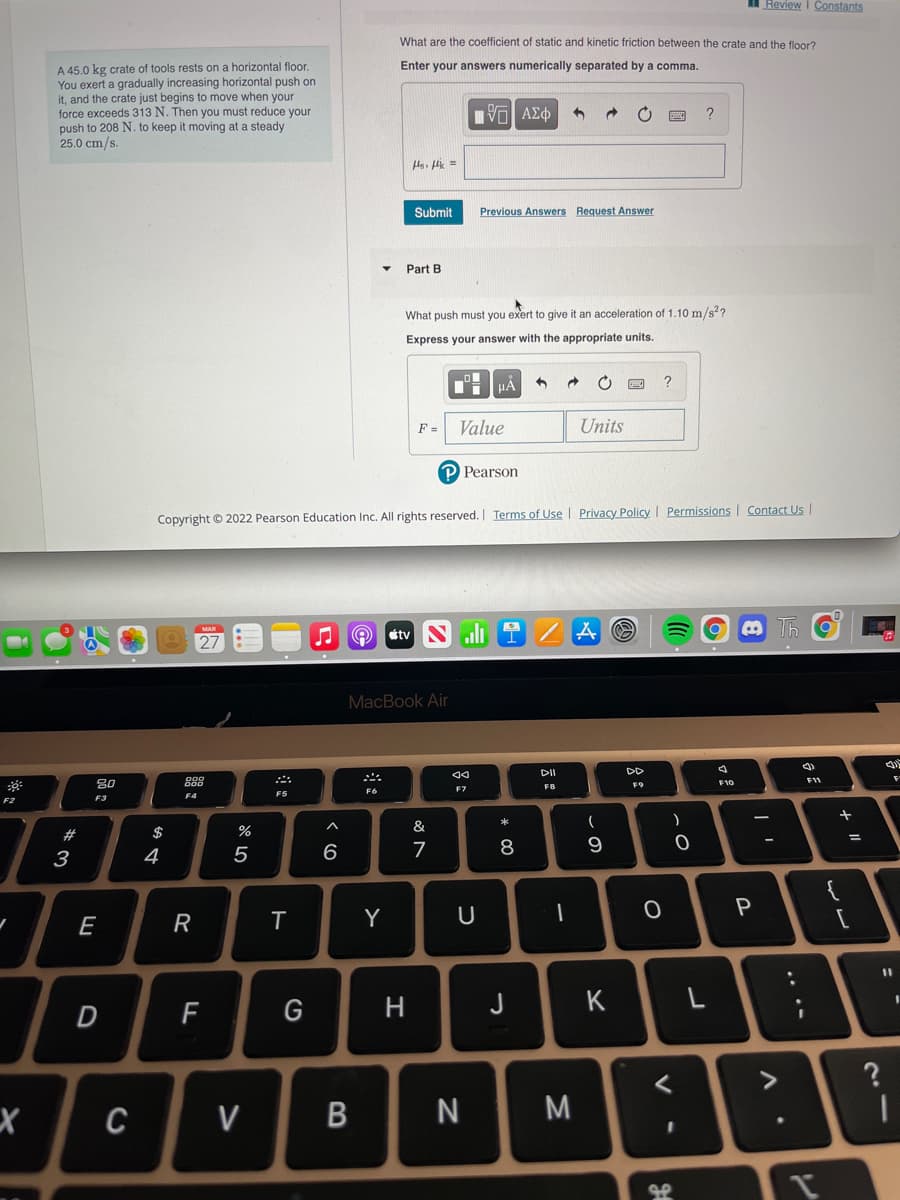What are the coefficient of Static and Kinetuc friction between the crate and the fioor? A 45.0 kg crate of tools rests on a horizontal floor. You exert a gradually increasing horizontal push on it, and the crate just begins to move when your force exceeds 313 N. Then you must reduce your push to 208 N. to keep it moving at a steady 25.0 cm/s. Enter your answers numerically separated by a comma. ? Ha Hk = Submit Previous Answers Request Answer Part B What push must you exert to give it an acceleration of 1.10 m/s?? Express your answer with the appropriate units. HA ?
What are the coefficient of Static and Kinetuc friction between the crate and the fioor? A 45.0 kg crate of tools rests on a horizontal floor. You exert a gradually increasing horizontal push on it, and the crate just begins to move when your force exceeds 313 N. Then you must reduce your push to 208 N. to keep it moving at a steady 25.0 cm/s. Enter your answers numerically separated by a comma. ? Ha Hk = Submit Previous Answers Request Answer Part B What push must you exert to give it an acceleration of 1.10 m/s?? Express your answer with the appropriate units. HA ?
University Physics Volume 1
18th Edition
ISBN:9781938168277
Author:William Moebs, Samuel J. Ling, Jeff Sanny
Publisher:William Moebs, Samuel J. Ling, Jeff Sanny
Chapter6: Applications Of Newton's Laws
Section: Chapter Questions
Problem 36P: A 0.500-kg potato is fired at an angle of 80.0 above the horizontal from a PVC pipe used as a...
Related questions
Topic Video
Question

Transcribed Image Text:Review I Constants
What are the coefficient of static and kinetic friction between the crate and the floor?
A 45.0 kg crate of tools rests on a horizontal floor.
You exert a gradually increasing horizontal push on
it, and the crate just begins to move when your
force exceeds 313 N. Then you must reduce your
push to 208 N. to keep it moving at a steady
25.0 cm/s.
Enter your answers numerically separated by a comma.
Ha. =
Submit
Previous Answers Request Answer
Part B
What push must you exert to give it an acceleration of 1.10 m/s??
Express your answer with the appropriate units.
HA
?
Value
Units
F =
P Pearson
Copyright © 2022 Pearson Education Inc. All rights reserved. Terms of Use | Privacy Policy I Permissions I Contact Us |
étv
27
MacBook Air
DII
DD
80
F8
F9
F7
F6
F5
F3
F2
*
23
$
%
&
7
8
9
3
4
{
[
E
R
Y
G
H
J
C
V
M
9-2
.. .-
. V
B
Expert Solution
This question has been solved!
Explore an expertly crafted, step-by-step solution for a thorough understanding of key concepts.
This is a popular solution!
Trending now
This is a popular solution!
Step by step
Solved in 2 steps with 1 images

Knowledge Booster
Learn more about
Need a deep-dive on the concept behind this application? Look no further. Learn more about this topic, physics and related others by exploring similar questions and additional content below.Recommended textbooks for you

University Physics Volume 1
Physics
ISBN:
9781938168277
Author:
William Moebs, Samuel J. Ling, Jeff Sanny
Publisher:
OpenStax - Rice University

Physics for Scientists and Engineers, Technology …
Physics
ISBN:
9781305116399
Author:
Raymond A. Serway, John W. Jewett
Publisher:
Cengage Learning

Principles of Physics: A Calculus-Based Text
Physics
ISBN:
9781133104261
Author:
Raymond A. Serway, John W. Jewett
Publisher:
Cengage Learning

University Physics Volume 1
Physics
ISBN:
9781938168277
Author:
William Moebs, Samuel J. Ling, Jeff Sanny
Publisher:
OpenStax - Rice University

Physics for Scientists and Engineers, Technology …
Physics
ISBN:
9781305116399
Author:
Raymond A. Serway, John W. Jewett
Publisher:
Cengage Learning

Principles of Physics: A Calculus-Based Text
Physics
ISBN:
9781133104261
Author:
Raymond A. Serway, John W. Jewett
Publisher:
Cengage Learning

College Physics
Physics
ISBN:
9781285737027
Author:
Raymond A. Serway, Chris Vuille
Publisher:
Cengage Learning

Physics for Scientists and Engineers: Foundations…
Physics
ISBN:
9781133939146
Author:
Katz, Debora M.
Publisher:
Cengage Learning

Physics for Scientists and Engineers with Modern …
Physics
ISBN:
9781337553292
Author:
Raymond A. Serway, John W. Jewett
Publisher:
Cengage Learning